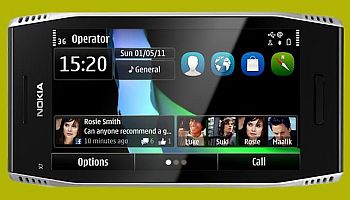Symbian Powered Nokia 500 Introduced

Nokia has introduced the Nokia 500 smartphone running Symbian, but will anyone buy it?
Nokia’s decision earlier this year to adopt Windows Phone as its primary software platform, continues to impact the Finnish handset giant.
Despite the clock ticking on Symbian however, Nokia seems determined to keep producing Symbian-powered smartphones, such as the newly-launched Nokia 500.
The Nokia 500 will feature a 3.2-inch capacitive touch display (with a resolution of 640 x 360 pixels), a 5-megapixel camera, and a 1GHz processor. Nokia claims the smartphone will offer some five to seven hours worth of talk time, 450-plus hours in standby mode, and around 35 hours worth of music playback.
New Era?
Complementing th at hardware is the Symbian Anna OS, whose revamped user-interface includes split-screen messaging, baked-in social networking, and what Nokia claims is a “better” browser.
at hardware is the Symbian Anna OS, whose revamped user-interface includes split-screen messaging, baked-in social networking, and what Nokia claims is a “better” browser.
Symbian isn’t the only homegrown operating system Nokia is loading onto new devices.
In June, the company introduced the Nokia N9, which runs a MeeGo operating system also slated for mothballing alongside Symbian. With a curved 3.9-inch AMOLED (active-matrix organic LED) screen and a body engineered from a single piece of polycarbonate, the smartphone is something of a proof-of-concept that Nokia can produce a higher-end, handsome device – as well as a possible indicator of the company’s thinking when it comes to Windows Phone.
“Innovation is the heart of our strategy, and today we took important steps to demonstrate a new pace of innovation at Nokia,” Nokia CEO Stephen Elop wrote in a 20 June statement tied to the N9’s unveiling. “It’s the beginning of a new era for Nokia.”
Soon after the introduction of the N9, Elop offered an audience a glimpse of what looked like one of the new devices running Windows Phone. The question is whether the Nokia 500 will follow suit as a possible form-factor for Nokia’s Microsoft-powered phones.
No Choice
Faced with a soon-to-be-mothballed set of operating systems, and immense competition from the likes of Apple’s iPhone, Nokia has been bleeding market share.
But for those questioning Nokia’s current strategy – i.e. announce the aforementioned deal, and then wait a few quarters until releasing Windows Phone devices into the market – at least one analyst is suggesting the Finnish phone-maker really didn’t have a choice.
“Nokia had to announce early its adoption of the Windows Phone platform because it had to take important cost write-downs in R&D that would have been impossible to hide,” IDC analyst Al Hilwa wrote in a 25 July research note.
Even if Microsoft and Nokia had managed to keep the deal a secret, he added, Nokia would have still faced significant declines in its smartphone market share. “For one thing, the Symbian R&D albatross would have continued to hobble Nokia’s profitability and its ability to make change,” he wrote. “For another thing, the platform dithering and in-fighting would have continued and leaked out anyway.”
Nokia can only hope that its next generation of smartphones will change its fortunes. In the meantime, devices like the N9 and the Nokia 500 offer a window – or Windows – into its thinking.